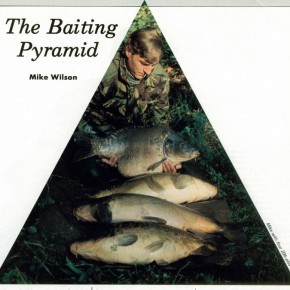Unlike today where massive carp are regularly featured in any number of dedicated magazines it only took a 20lb fish to make the angling headlines in the 1970’s. The ‘modern era’ of hair rigs, bolt rigs and long range fishing was still someway off and the capture of any carp, let alone a big one, was considered an achievement. There was very little in the way of ‘off the shelf’ carp tackle or information so most anglers innovated and improvised their way forward creating new tackle and strategies to outwit their quarry.
One of those anglers was Mike Wilson who pioneered a way to selectively catch bigger fish… a method that still stands the test of time and should be part of every anglers armory.
A little known water…
Until 1980 Ruslip Angling Club held the exclusive fishing rights to a 68 acre gravel pit in the Colne Valley. In spite of a significant stocking program in the late 50’s and 60’s only a couple of the members even fished for carp in the early seventies, one of them being Mike Wilson. As a member since the late 1950’s Mike had been instrumental in the creation of the now famous Savay Lake as a fishery. As the lake flourished and the various stockings of carp began to thrive he quickly recognized Savay’s potential for producing big carp. However his early attempts were continually frustrated by the intrusion of smaller carp and other species that were limiting any opportunity to consistently focus on the larger fish that he had seen.


Before the Hair Rig
Particle fishing was very much in vogue with baited hooks, light tackle using 6-8lb line, small 0.5 – 1 oz running leads and close range margin fishing. Baits were typically ‘side’ hooked so that the bait sat along the shank leaving the point exposed to give the best chance of of securing a hook up. However the ability of even the most confidently feeding carp to rapidly eject a baited hook required equally lightening fast reactions by the angler. The ability to say alert and hit the slightest line movement was known as ‘twitching’ (which is also how most anglers generally behaved after a night long session staring intently at the rod tip…).
Attention to detail
As a perfectionist Mike always looked (and still continues) to refine his tackle and techniques. He modified his alarms to achieve incredible sensitivity, carefully set-up his rigs and minimized anything and everything that might spook a wary carp. On the bank Mike took every precaution to avoid disturbing the fish and when fishing the margins even erected a screen to avoid any bankside movement spooking fish. His chair was positioned right next to the rods so that he could hit even the smallest line movement (even in the current ‘bolt’ rig era its amazing how many more fish, and big ones at that, would be landed if anglers learnt to strike even a 1-2″ bobbin lift or drop). Lightweight ‘bobbins’ were cut from plastic cups and if necessary a couple of split shot attached to counter any drift while a ground sheet kept everything tidy and reduced the risk of line tangles. The ground sheet also allowed the underlying grass to look relatively untouched so that the casual passer by might not even notice someone else had been fishing that particular spot.
Animal Behavior
A TV documentary on the hierarchical & competitive nature of animal behavior set him thinking. It described a ‘Pyramid’ of fewer, larger and more dominant members of an animal herd pushing out their more numerous smaller brethren at the watering hole or feeding area. So why not apply this assumption to carp? Mike devised a strategy for a ‘Baiting Pyramid’ that required ‘feeding’ the lake margins for several weeks before even attempting to fish so that the carp from all over the lake would eventually find the baited areas and grow increasingly confident. If his ‘Baiting Pyramid’ theory proved correct the larger carp would also stake their claim over the smaller fish in the swim. The question was would it work in practice?
As he would need large quantities of bait Mike initially chose sweet corn as he had a friend who worked in the frozen food industry. However when this source ran out he switched to maize (feed corn) as it was both inexpensive and plentiful. In early August Mike spent several weeks patiently ‘chumming’ the margins and a couple of swims. The key he felt was to resist any temptation to fish before the larger, hopefully more dominant, carp had established their authority. As the weeks passed the swims soon began showing signs of eagerly feeding carp and it took enormous reserves of will power to resist the temptation of putting a line out… When the time finally arrived to start fishing Mike was not surprised to find that the takes were supremely confident. Remember this was when the bait was mounted on the hook (before ‘hairs’ and ‘bolt rigs’) so a 1-2” ‘lift’ needed to be hit before the hook was ejected!

In an era where most anglers were lucky to catch one or two ‘doubles’ in a session and only a dedicated few landed a handful of fish over twenty pounds in an entire season Mike’s results were nothing short of spectacular. That fall he took twenty-three fish; ten doubles, seven low to mid twenties, six fish over twenty-nine pounds, and the crowning end to his carp season – a low thirty. At the time Mike avoided any publicity but his passion for large format photography dutifully recorded his outstanding success and what was a truly remarkable achievement rightly takes its place in carp angling history. Mike even applied to join the British Carp Study Group (BCSG) run by Peter Mohan. As was required he was duly interviewed but his application rejected as no one believed he could possibly have caught all the fish he claimed. If they had asked to see some evidence Mike might (despite the publicity ban on Savay) even have shown them some of the photos sitting in the trunk of his car… they’d have been blown away!

In 1979 Mike introduced me to Savay and a new level of carp fishing – an extraordinary apprenticeship. Sadly by the end of that season Savay’s cover had been ‘blown’ and its potential for big carp made it a focal point for every top carp angler in the UK. Walking along the bank at the start of the fishing season in June 1980 was an introduction to the Who’s Who of the carp world – Rod Hutchinson, Andy Little, Lenny Middleton and Kevin Maddocks to name but a few. That summer and fall the night air echoed to the repeated ‘thwack’ of high performance catapults firing boilies to distant swims while self hooking hair rigs took away the stress of hovering over rods waiting for the slightest ‘twitch’. The modern carp era had arrived and big fish photos began to adorn the magazines.
Does the “Baiting Pyramid’ still work today?
In reality it is possibly even more relevant here in the USA where many waters are yet to reveal their true potential. In addition to trying to single out the bigger fish a consistent baiting program is usually needed to simply divert the carp away from their regualr feeding routines and dependence on natural food.
In 1996 I discovered a large body of water that showed potential but offered limited access and little in the way of under water features that might be targeted as ‘feeding’ areas. I chose one of the few accessible swims and initially began baiting over a large area. The idea was to intercept carp as they patrolled the lake and hopefully ‘focus’ them over time by reducing the size of the baited area. Following Mike’s advice I restrained my eagerness to fish and continued baiting for almost 3 weeks. Then with a subtle twist to his theory, began reducing the quantity of bait a few days prior to fishing (mostly feed corn plus a sprinkle of boilies) in the hope that it would further increase the competition amongst the larger fish.
The initial results proved a little disappointing as I started with a couple of morning sessions and only ended up with only a couple of low doubles and a fish around 5lb. However on my first evening session it was all action and produced 3 high teens and 2 twenties, the biggest going 26lb. After thinking about it some more the ‘light’ eventually went on… So far I’d only baited in the evenings so naturally the bulk of the fish had been ‘conditioned’ to appear at that time for their daily feed.

For several weeks almost every session produced a twenty and nothing under twelve pounds. So far fish to twenty-eight pounds had been taken but I was certain there was more to come… in early September two friends joined me for an evening session and as darkness approached one of my Delkim’s sounded and settled into a reassuring blur of sound as a fish peeled line off the bait runner. At first the fish kited wide to my left before I had any sense of the battle to come. This was clearly a very strong, solid fish that stubbornly refused to give up for what seemed like an eternity. As it finally rolled over and into the waiting net we all gasped – it looked huge. But just as we lifted my fish clear of the water another alarm sounded – this time Chris was in and while he played his fish yet another alarm went off and Steve was also hooked-up. In a little over 30 minutes we each landed a fish over thirty pounds – All fully scaled commons and weighing-in at an incredible thirty-one; thirty-four and thirty-six pounds, respectively. Once again the ‘baiting pyramid’ had worked its magic.
Since that early result I’ve continued to use the Baiting Pyramid successfully over the intervening years here in North America. In 1996 I used boilies fished over particles (mostly maize) but have now tended to fish either one or the other instead of together. I’m a big fan of particle baits in the summer but tend to focus on a boilie only strategy in the Spring and Fall it seems to sort out the bigger fish on a more consistent basis. However don’t take my word for it… give it a try for yourself and don’t be afraid to experiment or tailor it to your own waters.
Getting up to date…

After having Savay almost to himself for 20 years Mike eventually moved on to focus on other species once the syndicates took over. In addition to his passion for researching angling history, collecting angling memorabilia and vintage tackle Mike still manages some time on the water to add to an already impressive list of specimen fish.
Along with the greatest names of carp fishing Mike was recently recognized for his contribution to carp fishing with his induction to the Carping Hall of Fame at the recent 2013 Carpin’ On Show. In addition to creating the Baiting Pyramid Mike was also responsible for the development of coated leads and latching LED’s on alarms.

If you enjoy a good read then I recommend the recently published book by Rob Maylin on Mike Wilson as part of the Big Carp Legends series.
http://www.bigcarpmagazine.co.uk/buy-books.html



great article iain, as you know im a big fan of the boilies and heavy baiting approaches so enjoyed the read. i think too many anglers are hung up on which bait (brand, smell, flavour, color) and dont realise that tyhe baiting APPROACH is actually more important.
Iain was a very successful specialist angler in the UK catching a number of big fish of all species and has continued this across the ‘pond’. I’m certain he can offer good advice for his fellow anglers if asked.
Tight lines fellas
Mike Wilson